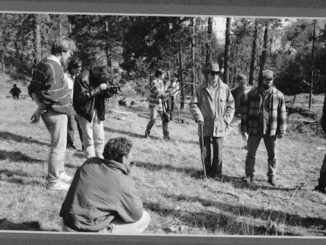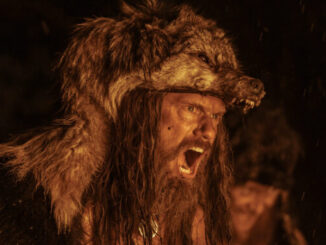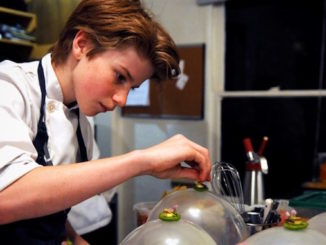In Ace in the Hole (1951, dir. Billy Wilder), a cynical journalist conspires to delay a cave-in rescue, counting on the ensuing media circus to bolster his career. The journalist (Kirk Douglas, in a career-defining role) finds many who are willing to conspire with him: the unhappy wife of the trapped man; the photographer eager for a big break; the election-season sheriff bribed with glowing press coverage. As the days drag on, massive crowds descend on the rescue site, a literal carnival taking shape with rides and souvenirs and tacky photo opportunities. Ace in the Hole is a bitterly satirical condemnation of a headline-hungry newsmedia, and the ravenous appetite of the media-consuming public.
National Geographic’s new documentary, The Rescue, is a seventy-years-late riposte to Mr. Wilder. Documenting the true story of the 2018 Thailand cave rescue, it celebrates the courageousness of rescue cave divers (including one who died in the attempt) and the media fervour the crisis engendered. Told through a combination of breathless contemporary reporting and one-year-later talking head interviews with those involved, it’s a moving, enjoyable docu-thriller where, even though we already know the outcome, we’re captivated nevertheless.

In June 2018, a junior association football team went missing while spelunking in the Tham Luang Nang Non cave system in northern Thailand. The adult coach and twelve players, aged eleven to sixteen, found themselves trapped when heavy rainfalls flooded the caves. With no way to contact the outside world, they spent a week with no one even sure if they were alive; The Rescue makes it clear that, behind the scenes, preparations were underway for a thirteen-person funeral.
The Rescue does not tell the story of the football team, not exactly. With the team’s story rights tied up at Netflix, NatGeo/Disney scooped up the story of the rescuers, choosing to focus primarily on the team of cave divers led by an eccentric bunch of Brits and Australians deemed “the best in the world.” (There’s a great moment where we see the Thai authorities mulling over a hastily-scribbled list of proposed divers, then cut to those very dudes catching a plane to Thailand less than 24 hours later.)
While it’s disappointing to not hear from the rescued, the documentary does spin a compelling story out of the rescue efforts. That includes the thousands of soldiers and volunteers, many of whom flew in from other countries, the hundreds of rescue workers and first responders, and a team of 100+ divers. Remarkably, more than a billion litres of water was pumped out of the caves in order to lower the water to “safe” levels for diving. Though not entirely safe: the film acknowledges the fate of Saman Kunan, a former Thai Navy SEAL who died while bringing supplies to the trapped team. Oddly, however, the film makes no mention of Beirut Pakbara, a Thai Navy SEAL who died a year later due to a blood infection contracted during the rescue.

A Werner Herzog-type could probably get a lot out of the team of oddballs who make up the “best cave diving team in the world”. That includes the Australian anaesthetist who, when asked for a way to keep the children calm during the hours-long dive out of the cave, invents a sedative concoction designed to knock them unconscious. Dr. Richard Harris is the first to admit that he more or less made it up as he went along, with no guarantee that any member of the football team would get out alive. (We learn in The Rescue that the divers had an escape plan in place, in case the rescue failed and the notoriously harsh Thai justice system went after them.)
Then there are the nominal stars of The Rescue, hobbyist cave divers Rick Stanton (a firefighter) and John Volanthen (an IT consultant). Stanton and Volanthen are impressively level-headed while under pressure (and, well, under pressure). Before The Rescue, each had firsthand experience with diving deaths, both as volunteer dive rescuers, and on their own recreational dives that went wrong. Their level-headedness in the face of extraordinary danger, not to mention the weight of a whole world watching, is nothing short of remarkable.
The Rescue is not, however, directed by Herzog (nor Wilder, for that matter), and its Disneyfied lens glosses over some of the story’s more out-there elements. A Burmese religious guru pops up briefly to assuage frightened parents, but it’s hard not to imagine a Herzog-type spending more time with this interesting character. The Rescue also completely ignores the controversy over the coach’s decision to enter the caves mere days before the rainy season. Also unmentioned is Elon Musk’s bizarre “intervention”, in the form of (a) tweeting his design for a kid-sized submarine, then (b) tweeting to accuse one of the rescue divers of paedophilia. If the upcoming Hollywood adaptation doesn’t feature, I dunno, Jared Leto in bad Elon Musk prosthetics, Ron Howard doesn’t know what he’s doing.
Look, Ron Howard probably isn’t going to do that; he’s as Disneyfied as The Rescue itself. In any event, there’s little chance of Howard’s version being as compelling as this documentary, with its clever combination of real footage and believable recreation, some of which appears to have been lifted from the 2019 Thai feature film The Cave. But where The Cave was an earnest but little-noticed recreation of these events, The Rescue is a fully-formed (if lopsided) documentary account for wider audiences. While its focus on the superstar divers, none of whom were Thai, robs it of, well, half the story, that can be blamed on story rights, not on the filmmakers. As it is, The Rescue is exciting, heartwarming, and celebratory. Hard to know what Billy Wilder would make of it.
Visit the official website for The Rescue here.



